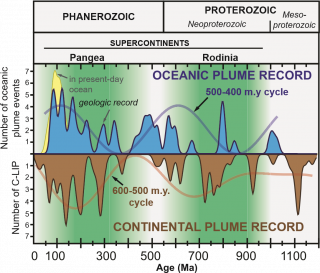Shall we dance — taking a 600 million year–long step at a time
Global geochemical fingerprinting of hot rocks risen from the deep by Curtin University researchers points to synchronised behaviour between tectonic plates and Earth’s deep mantle
Nearly 3000 km below and just above the boundary between Earth’s liquid outer core and the solid mantle, there are two gigantic hot yet dense piles of rocks, each hundreds of kilometers high and thousands of kilometers in diameter. Scientists can image the two gigantic “mountains” deep in the Earth because those rocks are particularly hot, and therefore make seismic waves travel slower, leading to the two regions being termed “large low shear-wave velocity provinces”, or LLSVPs. Some also call them superplumes. The question is, do the formation and evolution of the two superplumes have anything to do with what happens on the surface, for instance, the Pacific Ring of Fire?
Scientists believe that answering this question might help to resolve the “Holy Grail” of the plate tectonics theory: what drives plate tectonics and the Earth System in general? However, the scientific community is divided on what might be the correct answer. Some believe that the LLSVPs have been there, unchanged, since the very early days of Earth history. Others, like researchers in the Earth Dynamics Research Group, think otherwise.
In two recent articles in Nature Communications and Geology, our team of researchers report new evidence supportive of the hypothesis that the structure in Earth’s deep mantle is directly related to a phenomena observed on Earth’s surface — the formation and then break-up of supercontinents, like Pangaea, every 500 to 700 million years (see Figure 1). In the published research it’s shown that the eruption of hot volcanoes which tapped into the two LLSVPs or superplumes in the deep mantle come and go in a cyclic fashion, almost exactly synchronised with the 500 to 700 million year-long supercontinent cycle.

In the Nature Communications article, headed by PhD student Mr. Hamed Gamal El Dien, we scrutinised the chemical compositions of ~40,000 mantle derived rocks, which erupted onto both the continents and the oceanic floor over the past 3 billion years. It’s demonstrated that the lavas derived from the deep mantle as hot plumes are particularly rich in metals such as nickel and chromium, which can be used as a diagnostic “fingerprint” to detect changes in mantle plume activity throughout Earth’s history. In the article we further demonstrate that the identified plume intensity trend appears to coincide with the supercontinent cycle (Figure 2), thus supporting the previously proposed dynamic coupling between plate tectonics (the supercontinent cycle) and the formation and evolution of the LLSVPs or superplumes in deep Earth (Figure 1). In addition, this work shows that there is a consistent sudden drop in magnesium, nickel and chromium in the composition of the hot lavas ~3.2–3.0 billion years ago, indicating an abrupt drop in mantle temperature at that time. This abrupt cooling of Earth’s mantle is interpreted to reflect the start of global plate tectonics, which is another contentious yet fundamentally significant issue.

“I am so excited and happy to be involved in such cutting-edge research as a member of Curtin University’s Earth Dynamics Research Group to decipher the mysteries behind the evolution of our planet” said Mr Hamed Gamal El Dien.
In the Geology paper, headed by early career researcher Dr. Luc Doucet, and achieved through a collaboration with Canadian researcher Prof. Richard Ernst, the Curtin team presents the first Oceanic Large Igneous Provinces database. A database that contains data from rarely preserved oceanic mantle plume lavas, relics of ancient oceanic crust that, after being accreted to the continents, were exposed to the surface as mountain chains such as the Himalayas. Using this unique database, the team was able to reconstruct and compare the record of mantle plume activity in both the continental and oceanic realms for the last billion years, spanning the two supercontinent cycles of Pangea and Rodinia (Figure 3). The statistical analyses point to similar cyclicities between plume activity preserved in continents and that of the oceanic realm, both exhibiting a periodicity of ∼500 million years, comparable to that of the supercontinent cycle.

“Our discoveries demonstrate the presence of a dynamic coupling between LLSVPs and the supercontinent cycle and global subduction geometry, thus lending support to the model that the structure of the Earth’s deep mantle is, in the first order, controlled by the global subduction geometry linked to the supercontinent cycle”, said Prof. Zheng-Xiang Li, head of the Earth Dynamics Research Group. “Our work shows that the supercontinent cycle leads to the LLSVP or superplume cycle, but at the same time the superplumes cause the break-up of the supercontinents. So, the tectonic plates and the superplumes appear to have a chicken and egg relationship, yet the plates appear to have a slight upper hand”. “Our two recent papers lead the way for addressing the ‘plate tectonic driving force’ question from new directions, and new findings in the coming decade or two may enable us to more definitely answer this question”.
Contact persons: Hamed Gamal El Dien & Luc Doucet, Earth Dynamics Research Group, Curtin University.
Relevant publications:
Gamal El Dien, H., Doucet. L.S., Li, Z.X., 2019. Global geochemical fingerprinting of plume intensity suggests coupling with the supercontinent cycle. Nature Communications, 10, 5270. https://doi.org/10.1038/s41467-019-13300-4
Doucet, L.S., Li, Z.X., Ernst, R.E., Kirscher, U., Gamal El Dien, H., Mitchell, R.N., 2019. Coupled supercontinent–mantle plume events evidenced by oceanic plume record. Geology, In Press. https://doi.org/10.1130/G46754.1
Read the Curtin University Media Release:
Related articles:
